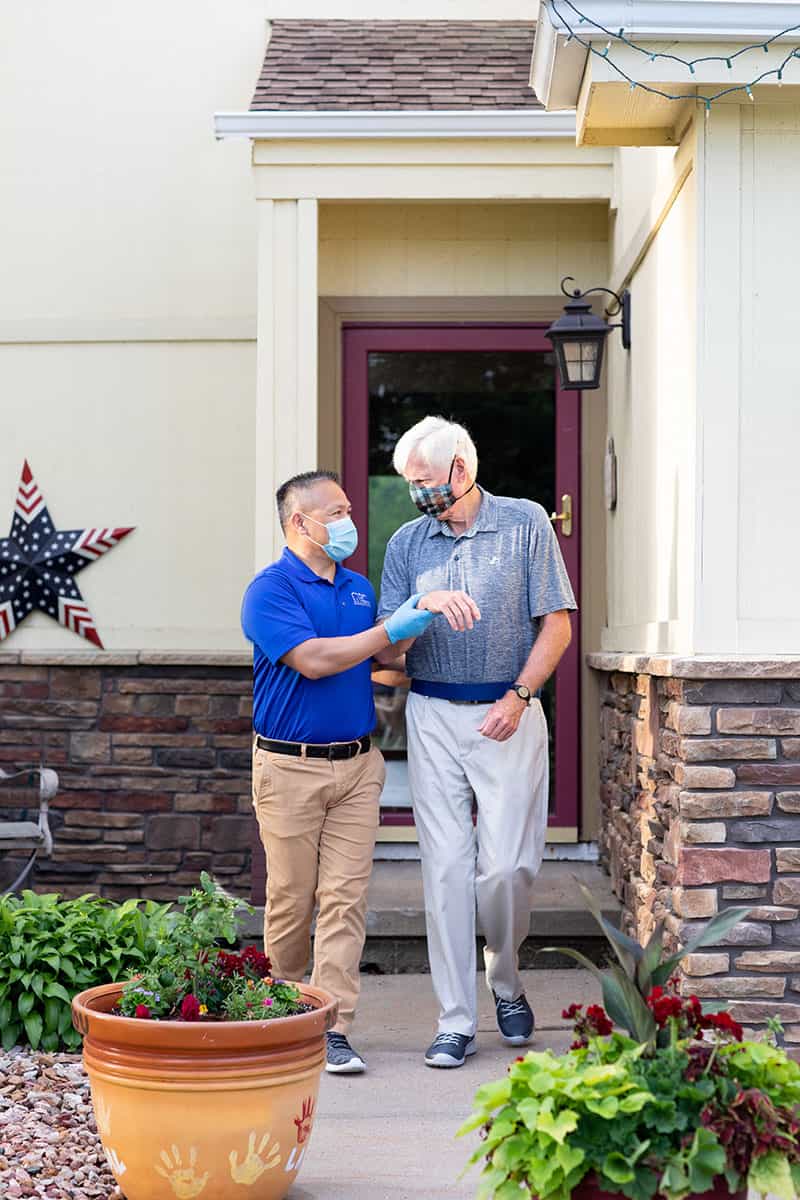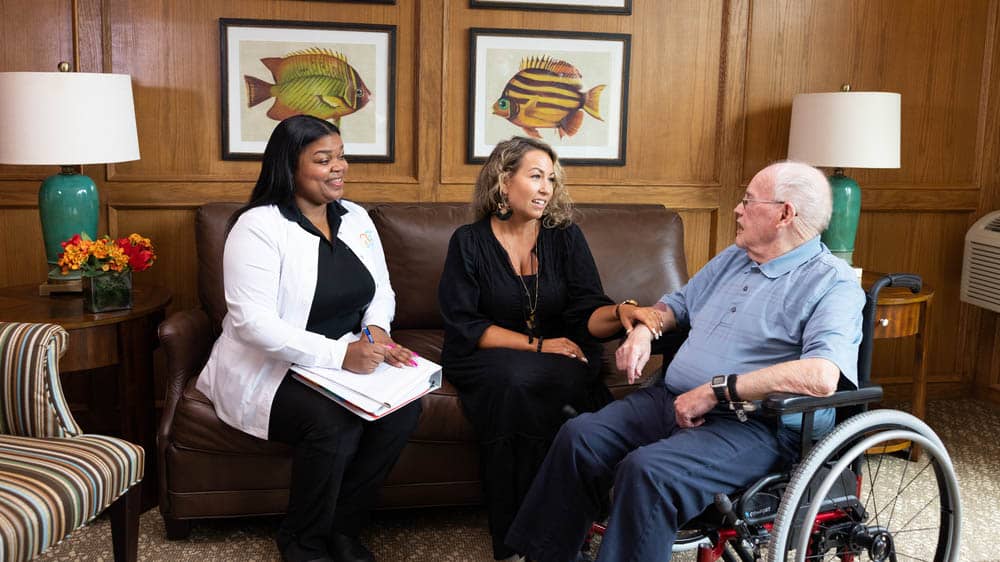

Healthy Vision Month
Each year, eye care experts celebrate Healthy Vision Month, a time to call attention to the importance of taking care of our eyesight. The past year has presented eye health challenges. For example, the Radiological Society of America reports that some COVID-19 patients have sustained eye damage ranging from pink eye to retinal damage.
This is more motivation to get the vaccine as soon as it’s available and to continue practicing social distancing and wearing a face mask as recommended during the pandemic. But quarantining offers its own problems, say eye care experts. Those include:
An increase in computer vision syndrome. These days, people are spending more time gazing into their computer monitor, smartphone or tablet. Instead of sitting across a conference table, we’re on a Zoom meeting. Instead of gathering with the grandkids in the backyard, we’re communicating with video chat. This puts us at increased risk of computer vision syndrome, also called digital eyestrain, which causes eye irritation, blurred or double vision, and difficulty focusing. Eye care experts remind us to blink often and follow the “20-20-20 rule”—take a 20-second break every 20 minutes while focusing your eyes on something 20 feet away.
A new cause of dry eye. Experts from the University of Waterloo in Ontario, Canada, shared information about a new syndrome: mask-associated dry eye (MADE). “Masks significantly reduce the outward spread of air,” the researchers noted. “However, exhaled air still needs to disperse; when a mask sits loosely against the face, the likely route is upwards. This forces a stream of air over the surface of the eye, creating conditions that accelerate tear film evaporation, leading to dry spots on the ocular surface and discomfort.” This discomfort also might tempt us to rub our eyes, a no-no when it comes to preventing the spread of the coronavirus. They recommend selecting face masks that are well sealed at the top and using lubricating drops.
Many seniors are missing their eye care appointments
Eye health professionals report that many senior patients have been avoiding coming in for regular care. This might be just a matter of putting off getting a new eyeglass prescription. But some are delaying their regular comprehensive eye exams and even treatment for eye conditions. Seniors should call now. Their eye care professional can describe safety steps their practice is taking at this time. Keeping those appointments can help detect several sight-robbing eye problems early on when they’re most treatable:
Glaucoma. Glaucoma is caused when fluid in the front of the eye doesn’t drain properly. Some types of glaucoma can rapidly cause vision loss, and immediate treatment is vital. More commonly, glaucoma develops so slowly that a person doesn’t realize they have it until their eyesight has been damaged quite a bit. A simple eye exam could detect the condition early on so treatment can begin. In either case, delaying prompt diagnosis and treatment could lead to loss of vision.

Age-related macular degeneration (AMD). AMD is the deterioration of the center area of the retina of the eye. Like glaucoma, AMD can come on slowly, with gradual loss of vision—this is called dry AMD. Regular eye exams are important because AMD can progress to wet AMD, in which abnormal blood vessels grow in the back of the eye, leaking fluid that can cause vision loss. Fortunately, today wet AMD can be treated, most often with regular, painless injections into the eye, which can dramatically slow the progression of the disease. Ophthalmologists warn that patients who skip these treatments risk losing more of their vision.
Cataracts. The lens of the eye can become thicker and cloudy, causing vision to be blurry, dim and dull. Fortunately, cataract surgery can dramatically improve vision. In this procedure, the doctor removes the eye's lens and replaces it with an artificial lens. Harvard Medical School experts note that cataract surgery has increased the average life expectancy in the U.S. as much as advances in cardiac care! Doctors report that some patients are postponing cataract surgery because of the pandemic, but they should be assured that practices are taking precautions to make this surgery safe.
Diabetic eye disease. People with diabetes are at greater risk of cataracts and glaucoma—and also for diabetic retinopathy, in which high blood sugar causes the blood vessels of the retina to swell, leak fluid or become blocked. Sometimes abnormal new blood vessels grow. People with diabetes should have regular healthcare appointments to manage the condition, as well as routine eye exams to detect problems early on when treatment can be most effective.
Low vision. Seniors who have already lost some or most of their vision may be extra-challenged at this time, when services they depend on may be harder to access. They should continue to work with their vision rehabilitation team to make the best of their remaining vision, learn new ways of doing things, and access technologies that can help, like smart speakers, audiobooks and video magnifiers. They may be spending more time at home, making it more essential to improve lighting throughout the house, remove hazards that could cause a fall, reduce clutter, and organize the home, so it’s easier to locate items needed for everyday living. Professional in-home caregivers can help identify these improvements and provide transportation to appointments.
Eye health professionals report that many senior patients have been avoiding coming in for regular care. This might be just a matter of putting off getting a new eyeglass prescription. But some are delaying their regular comprehensive eye exams and even treatment for eye conditions. Seniors should call now. Their eye care professional can describe safety steps their practice is taking at this time. Keeping those appointments can help detect several sight-robbing eye problems early on when they’re most treatable:
Glaucoma. Glaucoma is caused when fluid in the front of the eye doesn’t drain properly. Some types of glaucoma can rapidly cause vision loss, and immediate treatment is vital. More commonly, glaucoma develops so slowly that a person doesn’t realize they have it until their eyesight has been damaged quite a bit. A simple eye exam could detect the condition early on so treatment can begin. In either case, delaying prompt diagnosis and treatment could lead to loss of vision.
Age-related macular degeneration (AMD). AMD is the deterioration of the center area of the retina of the eye. Like glaucoma, AMD can come on slowly, with gradual loss of vision—this is called dry AMD. Regular eye exams are important because AMD can progress to wet AMD, in which abnormal blood vessels grow in the back of the eye, leaking fluid that can cause vision loss. Fortunately, today wet AMD can be treated, most often with regular, painless injections into the eye, which can dramatically slow the progression of the disease. Ophthalmologists warn that patients who skip these treatments risk losing more of their vision.
Cataracts. The lens of the eye can become thicker and cloudy, causing vision to be blurry, dim and dull. Fortunately, cataract surgery can dramatically improve vision. In this procedure, the doctor removes the eye's lens and replaces it with an artificial lens. Harvard Medical School experts note that cataract surgery has increased the average life expectancy in the U.S. as much as advances in cardiac care! Doctors report that some patients are postponing cataract surgery because of the pandemic, but they should be assured that practices are taking precautions to make this surgery safe.
Diabetic eye disease. People with diabetes are at greater risk of cataracts and glaucoma—and also for diabetic retinopathy, in which high blood sugar causes the blood vessels of the retina to swell, leak fluid or become blocked. Sometimes abnormal new blood vessels grow. People with diabetes should have regular healthcare appointments to manage the condition, as well as routine eye exams to detect problems early on when treatment can be most effective.
Low vision. Seniors who have already lost some or most of their vision may be extra-challenged at this time, when services they depend on may be harder to access. They should continue to work with their vision rehabilitation team to make the best of their remaining vision, learn new ways of doing things, and access technologies that can help, like smart speakers, audiobooks and video magnifiers. They may be spending more time at home, making it more essential to improve lighting throughout the house, remove hazards that could cause a fall, reduce clutter, and organize the home, so it’s easier to locate items needed for everyday living. Professional in-home caregivers can help identify these improvements and provide transportation to appointments.
An eye-healthy lifestyle
Medical care isn’t the only way patients can take care of their eyes. Following recommended beneficial lifestyle choices also may take a little more work, but it’s well worth it. Eye care experts offer this advice to older patients:
Avoid bad habits. Drink alcohol only in moderation—avoid the “quarantini” habit. If you smoke, quit. Smoking cessation programs are available through telehealth. And don’t forget your sunglasses when outdoors. If you’re leaving them behind because your face mask causes them to fog up, be sure your mask is properly fitted with an adjustable nose wire.
Exercise. Physical activity reduces the risk and progression of eye diseases. It also reduces the risk of falls, which are the No. 1 cause of serious eye injuries. During the pandemic, some of our regular exercise opportunities may be off-limits. For the time being, find alternatives. Work out at home, or go for a socially distanced walk if it’s safe. If you use professional in-home care, the caregiver can provide assistance and supervision indoors or out.
Eat a healthy diet. Fruits, veggies, whole grains and healthy fats promote eye health. If it’s hard to get fresh produce right now, try grocery delivery, or contact your local senior services agency. Professional in-home caregivers are helping clients eat well these days. The caregiver can go to the grocery store and prepare nutritious meals and snacks, as recommended by the client’s healthcare provider.







